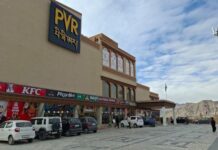The Producers Guild Of India has listed down basic safety rules to be followed by producers during shootings after the lockdown is lifted. These rules are to ensure Risk Protection Against Contagion of COVID-19 during filming. This document provides the basic methods for establishing technical and organisational measures for contagion prevention. Each filming is different, hence specific risk-based measures need to be established BEFORE it begins.
● Even after the decrease or termination of government preventive measures, the risk of contagion — albeit to a lesser extent — will persist in the first weeks and months, if not longer.
● It is common during a content shoot for different professions to participate in multiple projects simultaneously. Therefore, the risk on a content shoot is higher than in closed operations.
● Possible treatment, unless there are serious complications, lasts 3-6 weeks and is accompanied by local quarantine measures. This can endanger the entire project and should be taken seriously. The assessment of risks and the adoption of measures related to contagion must be part of the complex risk analysis in accordance with the existing directives of government.
● Follow the risk assessment methods, then determine the technical and organisational measures. Use the services of qualified professionals.
Provision of Handbook to cast and crew along with protective gear kit in order to sensitise and educate them on COVID-19 prior to entering the set which shall include the following:
General awareness about the novel corona virus.
Precautions — Dos and Don’ts.
Symptoms & stages of infection.
Information about testing & testing centres around Bombay.
Develop frequent hand washing and sanitization habits.
Cultivate good respiratory hygiene.
Promote distancing between each other.
Non-medical grade masks.
Disposable gloves.
Face shields.
Proper training about precautions to be taken during the shooting, to be given to all involved in the shooting — One classroom training and daily briefing for all workers. Carry out a drill every day like restaurants with entire staff regarding precautions so that it becomes a habit. All in-house office housekeeping staff hired directly or through third-party vendors to have mandatory COVID sanitizing/cleaning courses and certified training done.
Displaying posters to develop consciousness about preventive steps and promoting respiratory hygiene, hand washing & social distancing along with emergency helpline number, at easily noticeable/strategic places on shooting sets/dining place/edit rooms/fresh rooms etc.
Negative ion machine — ionizer (air purifier) that helps destroy bacteria — use it in the studio, sets and office to keep the air clean.
Monthly Swab Test like Microbiology Labs to check the sanitization of studio, sets and office.
There should be different sets of clothes and footwear for travelling and for the set. It would be ideal if transport can be provided to everyone on the set as travelling by public transport could be tricky.
Hair wigs/extensions must undergo deep cleaning before and after any application.
Art department must step up cleaning of props and surfaces throughout the shooting and between takes.
Product consumption shots must undergo a step-up in hygiene practices since sometimes an actor has to consume either a beverage or food, which needs to be handled well.
Sharing of cigarettes (often seen on many sets) should be stopped on sets/offices/studios.
The practice of 20-litre water jars being picked up from their opening cap should be strictly avoided. The loading/unloading of eatables/beverages should be done using moving trolleys to avoid hand contacts of multiple loading staff.
Cover all the equipment and chairs with thick plastic.
Certain staff should be designated as Stay at Home (STH)/Work From Home (WFH) on a rotational basis. Provide employees with Laptops and Dongles/Internet facility or allowance to ensure smooth functioning during work-from-home scenarios, wherever applicable. Ensure efficient IT infrastructural capability to maintain smooth operational flow. During this period, they should treat the same as “office working”, stay/work at home and be available for conference calls or remote login as prescribed. In case of any illness during this period, they must report the same to requisite authorities.
All Operational Managers must familiarise themselves with the Operational and contingency plans and explain the same to all staff working with them. Significant points for Safe Filming — recommended basic measures:
1. Tests for acting and related professions — All actors, stuntmen and possibly extras who come into contact with the actors should prove their state of health with a negative COVID-19 test. Tests according to the doctor’s recommendation must be in the form of swab, not rapid tests, which currently have low reliability. For the tests to be relevant, it is essential that actors after testing adhere to the quarantine rules. In this context, it will be important to consider testing when scheduling filming.
(a) Actors — Actors, stunt doubles and stuntmen being part of the scenes with actors must undergo testing just like actors and follow the same rules.
(b) Extras in scenes without actors — They should have their own department; they must wear face masks except during the shooting scene.
(c) Extras in scenes with actors — Where the shot requires a distance shorter than 2 m — must undergo testing just like actors and they must be separated from the other extras.
(d) Negative test in combination with following the quarantine rules — It can replace wearing a face mask — when necessary — for the key crew members. It is recommended to test the key crew members as their exclusion from filming, due to a suspected infection could endanger the entire project. eg. Make-up — Make-up artistes must have separately a set of make-up for actors and people at points ‘a’, ‘b’, ‘c’ and ‘d’ and separately for extras in scenes without actors. They are also required to wear respirators and protective gloves. It is recommended to consider having different make-up artistes for actors and for extras. Alternatively, artistes must be convinced and persuaded to carry out most of their get-up at their residence and visit sets with as little support staff as possible (ideally, just one). Preferably, same person/staff should handle artiste make-up and hair styling. Wherever possible, artiste should undertake his or her own make-up “minor touch-ups” throughout shooting, instead of the make-up artiste, to avoid contact with artiste’s perspiration.
2. Personal Protective Equipment (PPE) — Basic protective equipment can be divided into three categories: face masks (protects others), respirators (protects the wearer, but can spread the infection) and rubber/latex gloves. Masks, acrylic face guard, headgear and medical hand gloves for all actors, directors, hair, make-up person to be provided with proper instructions about their usage. Lightman or anyone who is lifting lights or other equipment to be provided industrial hand gloves with proper training about their usage. What to do:
(a) Determine which PPE you will use. Establish a system for the issuing, exchange and control of the use of PPE.
(b) Face mask — Count with 4 masks per 1 crew member over the 12-hour long shooting day. Applies to every person present at the shooting, including external contractors. The Shields worn by dentists to prevent splattering is a good option to cover the face, especially for artistes, make-up and hair people when in close proximity.
(c) Protective half mask with exhalation filter — An alternative to face masks for actors and crew is a protective half mask with inhalation and exhalation filter (easier breathing, filters can be cleaned, masks disinfected, higher protection standard than FFP3 and the crew member lasts longer when wearing it). It means lower costs, especially with a high number of filming days ahead.
(d) Respirators — in order to protect the entire crew, respirators — ideally of the FFP3 class — should be worn primarily by actors and crew members having a negative COVID-19 test.
(e) Protective gloves against viruses and bacteria — construction department and other designated individuals must wear protective gloves. Hazardous surfaces that actors are going to touch must be disinfected. (For disinfection of premises, it is necessary to support the construction department by temporary workers, for larger projects to hire specialised companies.)
(f) Protective gloves for other professions — crew members leaving the filming location (eg. production, drivers or runners, etc.) must be equipped with protective gloves to prevent contamination of the filming area.
3. Personal disinfection — It is important to follow the rules of personal hygiene during the filming:
(a) The same procedure as for PPE applies here: determine which measures you will use. Establish a system for dispensing, replacing and controlling use.
(b) Personal disinfection — If the scene being shot is extensive, crew members must carry pocket disinfectant wipes or a 30 ml. bottle of personal disinfectant, so they don’t have to leave during filming to hand disinfectant stands.
(c) Hand disinfectant stands — Stands with hand disinfectant gel need to be placed near the facilities, catering and directly on the set.
(d) Disinfection of objects — When filming in a public space in the city and in a place with a high concentration of people, it’s recommended to consider space disinfection by spraying (especially for large productions).
(e) Filming in vehicles etc. — Production should provide the disinfection of all vehicles, as well as the production should secure disinfection of the fleet that carries the crew and actors.
(f) Workspace disinfection — When filming in exteriors, make-up and costume department should disinfect their working stations and chairs for actors.
(g) Costume disinfection — It is important that the costumes undergo regular disinfection. The frequency will be dependent on the individual risk assessment.
4. On-site organisation — It is necessary to take into account — especially in the first few months — more space requirements for the use of locations in a public space, so that crew members can be separated, as mentioned above in point 2. At the same time, sufficient space must be available for the crew to eat so they can be spaced from each other. It is advisable to give priority to portable chairs over standard benches. Precautions to be taken about maintaining proper distance between various people on shooting location so that any containment of virus through touch, mouth, nose and eye is avoided. Create squares on the locations for everyone to stand, and people can only stand in those squares, else distancing will not be possible.
(a) Separation of specific crew groups — Key crew members, actors and other professions that are difficult to replace should be separated from the rest of the crew (eg. they should have their own costume room, facilities, make-up room, catering area etc.). Specific measures may vary from project to project and must be processed in an individual risk assessment.
(b) Transhipment points — It is recommended for large projects to set up transhipment points dedicated for suppliers outside the set with the possibility of disinfecting transported material.
(c) Limit the number of cast/crew & avoid outdoor shootings: Rotational Attendance System to be introduced with small and limited crews to be used for shootings. All the departments should be asked to keep condensed unit strictly with the exception of certain departments like Production Department, On-Set Security, Catering and Transport, which might have to increase their work strength to enforce and put into place COVID-19 work guidelines. Majority of the shootings to be planned in indoor sets, and outdoor locations to be avoided.
(d) Avoid senior cast and crew members above 60 years — Crew above the age of 60 years should be avoided at least for three months from the date of shooting as and when it starts and Cast above the age of 60 years should be judicially used.
5. Temperature measurement — Every crew/cast member should undergo temperature measurement with a contactless thermometer before the start of the shooting day and before entering the shooting location. Any new incoming sub-contractors must undergo temperature measurement upon arrival. Human body temperature limits must be in accordance with the country-specific health regulations. A junior-level MBBS doctor must be present on all sets for initial 3 months. A certified nurse should also be present on sets at all times. Create form for each person involved in the shooting, and the nurse should note down his temperature on the form, using a body temperature detector, and oxygen level, using a pulse oximeter, which is essential now. If oxygen level falls below 94, that person should be immediately checked. Details such as his mode of travel, medical history, age should be part of this form. Anyone with a high temperature cannot enter the set. Unit members to be issued an identifier once they pass temperature screening — for instance, wearing of a green sticker for clear screening identification. Any crew member who feels unwell during the course of the shooting must immediately report to the on-set nurse who must report to the production company. Ambulance shall be available on standby.
6. Catering — Staff members may be ideally advised to carry home-prepared food. It is necessary to make sure that food can be distributed in a takeaway fashion, when each crew member moves away from the catering after taking his food, so the social distancing rule can be adhered to. It is important to ensure that crew members have enough space when eating, to follow rules of social distancing (including refreshments during the day). There is no need to have more than one catering place if all meals, including main meals, are packaged separately. Also, use of disposable items — plates, cutleries etc. must be encouraged and for all the disposed items, a designated place should be provided to dispose off the same, and proper hygiene will have to be maintained. Only water bottles should be provided to the crew. There will be no usage of water dispenser. Tea, coffee etc. to be supplied through vending machines. Also, multiple food and beverages stations should be provided with microwave. Dry snacks, fruit juices, etc. to be placed only in the specified area so people just go and collect them in a self-service manner.
7. Securing the location — It is divided into securing the location and location recce.
(a) During filming — It will be important to ensure a consistent and a secure lock-up to prevent any unauthorised personnel from entering. Each shooting location to be provided adequate hand washing and anti-bacterial solutions/hand sanitizers/regularly refilled hand-rub dispensers should be strategically placed at all operational clusters, entry and exit points as well as in the proximity of food and beverages sections, so as to be used throughout the shooting by all crew members. Make hand washing mandatory for everyone with soap, on entry to the set. If possible, arrangement for bathing must be made. For those who are likely to come in close contact, such as hairdresser, make-up person, actors, use a mouthwash to gargle, that is normally provided at dental clinics. Record of each and every person should be maintained throughout the shooting schedule every day. This helps when anybody asymptomatic turns out to be positive, to determine the course of treatment and further course of action. CCTV cameras to be made mandatory on shooting locations and they need to be monitored regularly to check anyone showing symptoms of any disease including COVID-19. Dedicated COVID help on set to make sure that all the sanitization, check-in, check-out, on-set hygiene and safety procedures are maintained. One or two persons (referred to as Anti-COVID Boys) per set to be dedicated for this job.
(b) During pre-production — When the crew is recceing potential locations, the sites must be treated as if they were infected (unless they were disinfected ahead of the recce) and the crew must use PPE when recceing the site. The specifics to be defined in the risk assessment.
8. Necessary documentation — Each production should have these measures implemented in its risk assessments, and they should also require this implementation in risk assessments of their suppliers. If you need help with risk assessments, you can contact an authorised H&S specialist in your country. Before filming commences, production and suppliers need to become familiar with the risks and measures for filming (not only in terms of the risk of infection). This familiarisation must be confirmed in writing, for example, by signing the attendance list during the briefing training. Obligations to comply with these precautions and submit COVID-19 tests must be implemented in contracts with individual members of crew, as well as any sanctions and liability for damages in case of non-compliance. Information boards are recommended to be placed at the shooting locations. Bearing in mind that this is a fundamental change in workflow compared to the pre-pandemic time, reminder of measures in this form is important.
9. Management during filming — Measures adopted to secure any possible contagion must be coordinated at the filming location by a Film Safety specialist or Occupational Health and Safety (OHS) Manager or a trained authorised person who will be responsible for coordinating and supervising the anti-contagion measures. The differences between the individual coordinators in terms of competencies are:
(a) Production safety specialists — Participated in creating risk assessment, they are able and qualified to creatively adapt measures of OHS to the needs of the script based on their knowledge of production technology, problematics and its need. They coordinate work with risk assessments of sub-contractors and supervise correct documentation.
(b) OHS Managers — Are OHS qualified individuals for occupational safety management, they are qualified to modify the above measures — usually purely from the OHS perspective without an artistic context. They coordinate work with risk assessments of sub-contractors and supervise correct documentation.
(c) Trained authorised individuals (eg. production) — They are only authorised to observe the established measures by following a checklist prepared at the beginning of the shooting. They are not authorised to change the measures, but to assure their compliance and to monitor the training documentation.
10. Waste management — Disposable face masks, gloves, etc. must be treated as hazardous waste — the used ones to be put into solid plastic bags and to be handled with protective gloves and then disposed of. When fabric face masks are used, the crew members must have sealable plastic bags and also the possibility of boiling them for sterilisation purposes. If one of the members of the crew or sub-contractors has violated or refused to comply with the security measures taken, he would be excluded from filming. The full support from the producer will be crucial when implementing these measures.





























